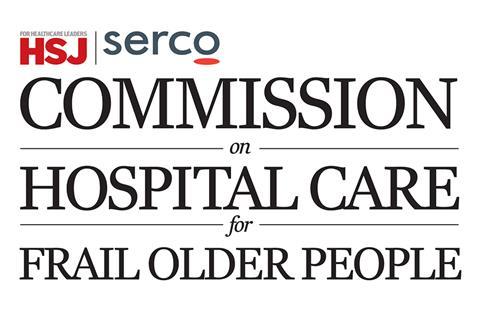Derby Hospitals Foundation Trust screens all acute admissions for frailty

Commission on hospital care for frail older people
The debate around how the acute care of older people with frailty attending hospital should be organised is dynamic and rapidly evolving. The recent move towards cohorting patients in specialist areas has shown benefits for some patients but it may not address the problem for the majority of those accessing acute trusts.
In March 2013, a multidisciplinary project team, led by Derby Hospitals Foundation Trust’s transformation team, was tasked with developing an improved pathway for frail older people admitted to the acute trust.
Under the new pathway, we screen all acute admissions for frailty on arrival in the emergency department or medical assessment unit. We have embedded a specialist frail elderly assessment team (FEAT) in our existing assessment unit, working alongside the geriatricians, other specialty physicians and acute physicians to provide comprehensive geriatric assessment (CGA).
Being placed within the acute medical department prevents a two tier system forming, allowing older people equal access to specialist services, regardless of frailty status.
Identifying frailty
Providing an intervention to frail older patients is dependent on being able to identify frailty. While many methods have been proposed in academic trials, a universally accepted screening tool for frailty in acute admissions does not exist.
At Derby Hospitals Foundation Trust we have been using a quick, pragmatic screening tool based on the clinical outcomes of frailty. Any healthcare professional can use this tool without addition training. Patients are asked four screening questions which indicate frailty (see box). These parameters were developed by the project team after reviewing the available published evidence.
Four questions for screening frailty
Answering yes to any of these indicates frailty
- Over 65 from a care home?
- Over 75 with confusion?
- Over 75 with falls or reduced mobility?
- Over 85 with four or more co-morbidities?
Testing the model
To assess the parameters’ validity, we audited 170 consecutive patients referred to the MAU. We recorded hospital number, age, admission observations and the clinical opinion of the senior medic regarding the frailty status.
Of the 170 patients audited, 73 per cent were over the age of 65, emphasising the changing demographics of the population presenting acutely to the MAU. Frailty was identified in 35 per cent of the patients, having at least one criterion from the frailty screening tool. Correlation between the tool and clinical judgement was good at 82 per cent for those identified as frail.
Based on this pilot, the tool was implemented on the MAU to identify older patients at risk of frailty, electronically flag them and provide CGA. For those at risk of frailty, a parallel multidisciplinary assessment can begin.
This allows the therapists to begin their assessment alongside, and in some cases before, a full medical review has taken place. This allows for expediting CGA and timely discharge where possible.
All patients are triaged by the consultant acute physician with patients having aspects of the assessment deferred while acute medical care takes priority. The team have access to speech and language therapy, dieticians, discharge facilitators and the psychiatry liaison team. Dedicated FEAT pharmacists undertake medication reviews and reconciliation.
Before the development of this team, a system of specialty on call was operating in the trust, whereby consultants from medical specialties attended the MAU every day, including weekends. The consultant geriatricians were supported by advanced clinical practitioners in this role. This resulted in up to 25 per cent of patients identified as requiring a geriatric review being discharged on that day.
During implementation of the new model, it became apparent that a team leader role was needed to coordinate the team with the MAU. To support the parallel assessment and CGA, a new admission document, based on the silver book principles, was developed and implemented by the project’s multidisciplinary team. This document has reduced duplication of work and streamlined discharges by doubling as the referral form for community services.
Initial assessment
FEAT was established in November 2013. More than 2,598 patients have been seen by the team with about 71 per cent of the patients identified getting home the same day if medically fit. Initial monitoring shows no increase in readmission rates; a full evaluation of the service is planned.
We have received positive feedback from the emergency care intensive support team for this innovative model as it makes frailty everyone’s business. We believe FEAT provides an alternative to frailty units, which are limited by the physical constraints of the ward environment.
The second phase of this project involves looking at how we ensure CGA is completed in all patients identified as frail with robust follow-up and case management in the community, as well as using this model in other departments in the acute trust.



























No comments yet